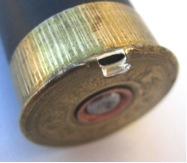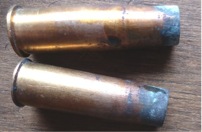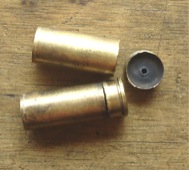
When we reload and fire out ammo, we naturally want to know how it performs. Two of the most common things we look at is the round’s accuracy and if it fed ok. If you are a little more serious, you may purchase a chronograph so you can measure the velocity and consistency of your loads. These are good ways to evaluate your efforts.
Something that many people overlook is how the brass looks after being fired. If you know how to read the signs, you will learn a lot on how your loads perform. An example is a load that has shown good accuracy and consistency but may be a little too warm for that particular gun. While it’s not usually dangerous, firing loads that are a little warm for a gun will wear out your brass quicker and cause excess wear and tear on the gun.
If the primers are loose after being fired twice, that is a pretty good sign that your loads are too warm. Factory loads have improved a lot in the last 20 years. If you try to exceed their velocities, you will be quickly met with a challenge. The most obvious is accuracy. The factories use powder that isn’t available to the average handloader so they have an advantage in that respect. If you know what you are doing, you can approximate them but seldom exceed their velocities. Careful load development can result in high performing and accurate loads.
There are signs to look for with mild overloads. With many modern rifles, the ejector is spring loaded. A mild overload will produce a shiny round mark on the case head. If you are using a book load that is listed as mild then perhaps the brass is too soft. That is unusual but very possible. Years ago, some manufacturers made their brass soft to be able to pick up pressure signs but that trend proved to be problematic and didn’t last very long.
Soft brass can cause an extractor to cut through the rim.
Cratered primers are not a reliable sign because some are softer than others. Unless you have additional info that it may be a warm load, disregard cratered primers. If you reload your cases after firing warm loads, your primers may be loose and unusable. That is one good incentive to not use max loads on a regular basis. Once the primer pocket is enlarged, the case is useless.
If your loads are way too hot, the signs become much more obvious. If the case sticks in the chamber, your load is excessively hot and should be backed off a bit. If you have that ammo, you will be better served pulling it rather than shooting it. If it is that hot, the primer will be blown out and the case will be swelled. Ammo loaded too hot is dangerous and shouldn’t be shot. Even a book load can sometimes be too warm in some guns. There are differences in the chamber and barrel dimensions of each gun.
If a case is severely corroded or dirty, it can also cause it to stick in the chamber. If that is the case, you will see small dents in the shell. The ammo will be conformed to the chamber upon firing. A swelled chamber will produce the same results. That is something that happens in older guns with soft steels. If you shoot loads that are too warm over a period of time, the chamber may swell and the locking lugs may be stretched.
Corrosion from black powder shooting area
Other readable signs are splits and excess headspace. Splits occur when brass has been fired a few times and resized. The brass hardens and becomes brittle. That is normal wear. Annealing the brass will soften it and make it more malleable. Unless it is an odd case, it probably isn’t worth the trouble. With straight cases such as 38 specials, the body may split after a few firings. Again, that is normal. Starline cases hold up very well and can be fired and loaded many times without any issues.
There are some problems with semi auto rifles in regards to reloading. Some types of ammo will have the rim partially or completely stripped from the case. Low quality cases can present problems. Excess loads or an incorrect powder can cause problems as well. Your choice of powders is limited with semi autos, especially the older military guns like the Garand. With these weapons, following the military specs as close as you can will offer the best results. With many semi autos, you will need a small base sizer die in order for them to chamber. Trimming the cases is also very important when making ammo for semi auto rifles.
Headspace is the distance from the bolt face to the part of the chamber that stops the round from going in too deep. The headspace is determined by the case design. Rimmed cases generally use the rim. Rimless bottleneck cases use the shoulder. The magnums use a belt for headspacing. A straight case uses the case mouth for headspacing. Excess headspace occurs when the chamber is too long and allows the brass to stretch, which can cause anything from misfires to case separation.
Another cause of case separation is the situation of a case that is slightly too long or improperly headspaced, allowing the case mouth to get into the forcing cone of the barrel. When the round is fired, the bullet tries to take the mouth of the case with it, while the head of the case is moving backward to find the breech face. If it doesn’t pull in two the first firing, it most certainly will the second.
Separated case due to excess head space
A sign to look for is a shiny ring about ¼” in front of the rim. This is a good indication that the chamber is too long. The ring may appear as a slight groove. If this is the case, the brass should be discarded. You can take a dental pick and feel the inside of the case. If you find an area that catches, that case should not be used. High pressure doesn’t cause case separation but it can cause problems if the gun has excess headspace. Case separation can be dangerous. It also becomes a hassle removing the front portion of the case from the chamber.
Fixing a headspace issue is usually expensive and requires a gunsmith with the correct tooling. In some cases you can work around it by simply setting your sizing die back a little. When you size brass, the shoulder is pushed back. If it is pushed forward excessively and then sized in a normal manner, the case will separate. If you set your die so it sizes the case just enough to chamber, the shoulder won’t be worked as much. The 303 British rifles had a chamber with generous dimensions to function in less than ideal conditions. While the design worked as intended, it didn’t do handloaders any favors.
In theory, the more consistent the brass is—the more accurate the gun will be. I say in theory because the gun itself has to have tight tolerances in order to take advantage of the quality of the brass. Starline’s brass is the highest quality I have found. Older guns, especially military weapons, were built with loose tolerances to be reliable under battle conditions. They also didn’t have the precise machinery used today when they were built.
If you shoot matches with a premium type rifle, consistent cases become more important. Starline’s brass has tight tolerances and is always consistent. Competition shooters prefer brass with consistent weight, neck thickness, and flashhole size. Some of the items mentioned in this article seem small, but when a ¼” group difference can take you from 1st place to 20th place in a match, everything counts.